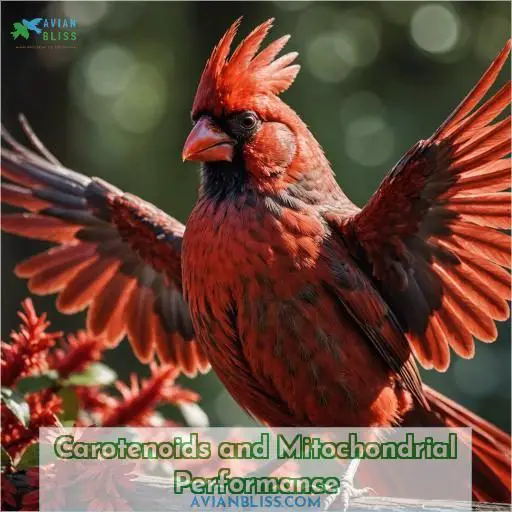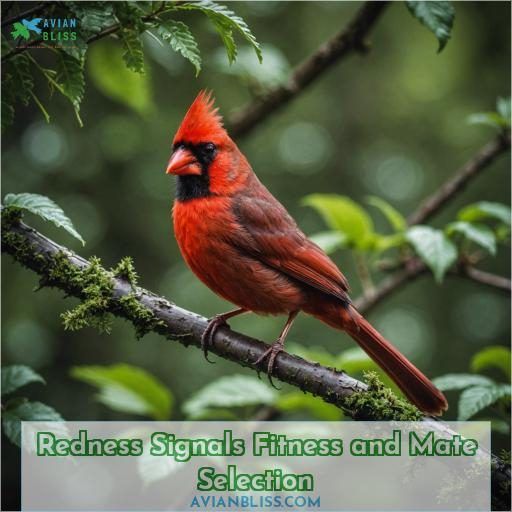This site is supported by our readers. We may earn a commission, at no cost to you, if you purchase through links.
 You’re drawn to the vivid red plumage of cardinals because of carotenoid pigments from their diet.
You’re drawn to the vivid red plumage of cardinals because of carotenoid pigments from their diet.
Carotenoids concentrate in mitochondria, powerhouses that fuel cells, enabling peak performance.
Vibrant crimson signals robust mitochondrial function and overall fitness, making the male irresistible to females during mating season.
The redness intensifies after molting, reaching its brilliant peak by midwinter when reproductive success is influenced, especially in rural habitats.
Providing native, carotenoid-rich plants like dogwoods guarantees cardinals maintain their iconic red hue.
If you’re curious about the deeper reasons behind this phenomenon, read on.
Table Of Contents
Key Takeaways
- Cardinals’ vibrant red plumage is due to carotenoid pigments obtained from their diet, which concentrate in the mitochondria and boost cellular performance
- The brightness of a male cardinal’s red feathers signals his overall fitness and health, making him more attractive to potential mates
- Cardinals’ red coloration reaches its peak brilliance by midwinter, which may influence their reproductive success, especially in rural areas with more abundant carotenoid-rich food sources
- Providing native, carotenoid-rich plants like dogwoods and winterberries can help support the iconic red hue of cardinals in urban and suburban areas
Why Are Cardinals Red?
Cardinals are red due to their diet of carotenoid-rich foods, which provide the pigments that give their feathers their distinctive bright red color. This redness signals the cardinal’s fitness and health to potential mates, helping them attract a partner and reproduce successfully.
The Love for Carotenoid-Rich Foods
You’ve likely noticed male cardinals’ vibrant red plumage. This coloration comes from carotenoids found in rich fruits and native food sources.
Cardinals need these nutrient-filled treats to achieve their brilliant hue. However, in urban areas, an overreliance on invasive honeysuckle may actually dull their redness and impact their nutritional status.
To support your local cardinal birds, offer carotenoid-rich foods like dogwood or winterberry for best coloration.
Carotenoids and Mitochondrial Performance
You’re intrigued by the connection between those bright red feathers and a cardinal’s health, aren’t you? Well, it turns out carotenoids play a key role in mitochondrial performance. These biochrome pigments concentrate in the mitochondria, the powerhouses of cells, and:
- Higher carotenoid levels boost mitochondrial efficiency
- Improved mitochondrial function enhances overall health
- Vibrant red coloration signals robust mitochondrial performance
The redder the cardinal, the better its mitochondria are humming along. It’s a telltale sign of a bird in top condition.
Redness Signals Fitness and Mate Selection
The bright crimson plumage of male cardinals serves an essential biological function: it attracts potential mates and signals the bird’s overall fitness and health. Carotenoid pigments, which contribute to the brilliant red hues, are also concentrated in cellular mitochondria, the energy powerhouses linked to physical performance and stamina.
Bright Plumage Attracts Mates
As a male cardinal, your bright red feathers are a surefire way to attract potential mates. Females are drawn to the vibrant hues, as they signal your superior genes and ability to produce healthy offspring. By efficiently metabolizing carotenoids from your diet, you can flaunt your plumage and increase your chances of mating success within the cardinal range.
Carotenoids Indicate Health
The vibrant crimson plumage of male cardinals doesn’t merely attract mates – it also signals their overall wellness and robustness. Behold, these resplendent feathers are forged by carotenoids, potent antioxidants that bolster the immune system and reveal a bird’s foraging prowess and aptitude at evading predators. A cardinal’s redness is a veritable beacon of vitality.
Redness Signals Mitochondrial Performance
The bright red plumage of male cardinals doesn’t just attract mates – it also signals their mitochondrial performance. Carotenoids, the pigments that give cardinals their vibrant color, are concentrated in the birds’ mitochondria, the powerhouses of their cells. Redder cardinals have more efficient mitochondria, indicating superior health and fitness that females find irresistible.
Molting and Peak Redness
Cardinals go through an annual molt where they shed and regrow their feathers. During this process, their red coloration reaches peak brilliance by midwinter, with the intensity potentially influencing reproductive success, especially in rural environments.
The Brightest Red Coloration is Reached by Midwinter
As cardinals molt their feathers in late summer and early fall, their brilliant red plumage reaches its peak brilliance by midwinter.
This seasonal timing is no coincidence. The brightest red coloration may signal a male’s fitness and influence his reproductive success, especially in rural areas where native fruits are more abundant.
The cardinal’s iconic red hue is truly a marvel of nature.
Redness May Influence Reproductive Success, Especially in Rural Areas
As the winter months approach, cardinals reach their peak redness. This brilliant coloration may be especially important for reproductive success in rural areas, where carotenoid-rich foods are more abundant. In urban settings, non-native honeysuckle berries may limit carotenoid intake, leading to duller plumage and poorer body condition. Providing native plants can help support cardinal health and nesting success.
Native Plants Support Cardinal Coloration
To keep those iconic red cardinals looking their best, you’ll want to fill your backyard with native plants that provide a carotenoid-rich diet.
Fruits like dogwood berries, grapes, and raspberries are cardinal favorites and packed with the pigments that give these birds their vibrant plumage.
By creating a habitat of native plants, you’re aiding cardinal conservation.
You’re also ensuring these beloved birds have access to the essential nutrients they need to maintain their stunning red coloration year-round.
It’s a mutually beneficial situation for you and your feathered friends!
The Iconic Red Cardinal
The iconic red cardinal is a beloved symbol across the eastern United States. These vibrant birds captivate us with their striking crimson plumage, which stems from their carotenoid-rich diet. But the cardinal’s allure goes beyond mere aesthetics – their redness signals superior genes, health, and fitness. Cardinals are monogamous, and females choose mates based on the brilliance of their red feathers. After all, a bright red male cardinal isn’t just for show – it’s a demonstration of his ability to produce strong, healthy offspring. No wonder these charismatic birds have become such an integral part of our natural and cultural landscapes.
- Cardinals are the state bird of 7 U.S. states
- Their red color is a result of carotenoid pigments in their diet
- Brighter red males are more attractive to female cardinals
- Cardinals are monogamous and mate for life
- Keeping cardinals as pets was once legal, but is now prohibited
Frequently Asked Questions (FAQs)
Can cardinals use birdhouses for nesting?
Ever wondered why cardinals don’t use birdhouses? Their careful nesting style requires reliable support for their cup-shaped nests, typically built in thick shrubbery or tree branches. Providing suitable vegetation is crucial to attracting these lively backyard visitors.
Are there any rare color variations of cardinals?
You’re right to ask – cardinals do occasionally exhibit rare color variations. While the brilliant red is standard, you may spot yellow, orange, or even white cardinals on a lucky day.
Was it ever legal to keep cardinals as pets?
You’re in for a surprise – keeping cardinals as pets was illegal, yet some couldn’t resist their vibrant charm. These feisty crimson beauties demand specialized care and ample space to thrive. Responsible avian enthusiasts understand: appreciating cardinals means respecting their freedom in nature’s embrace.
How did the northern cardinal get its name?
You’re curious about the northern cardinal’s name? Its vivid red plumage inspired the cardinal moniker, referring to the rich robes worn by Catholic cardinals. This striking bird was named for its vivid, cardinal-red coloring.
Do cardinals eat suet from bird feeders?
You bet your feathers cardinals eat suet! This high-energy treat is a favorite among these crimson-cloaked songbirds during the colder months when natural food sources are scarce.
Conclusion
Ultimately, understanding why cardinals radiate redness reveals nature’s intricate beauty. Providing purposeful plantings preserves their pigmented plumage, perpetuating this iconic bird’s allure. Appreciating carotenoids’ role in signaling fitness via mitochondrial function deepens our admiration for these crimson creatures’ evolutionary adaptations.








